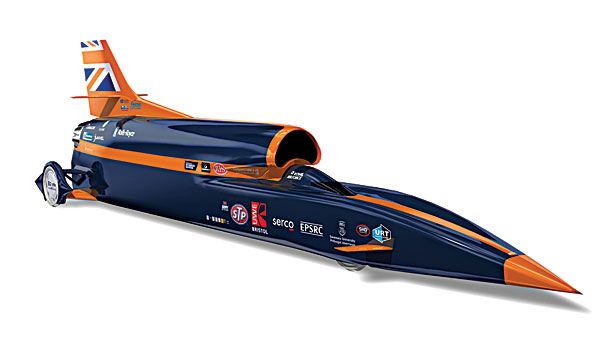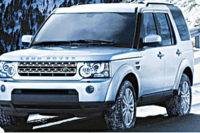Pencil-shaped, the Bloodhound SSC supersonic car aims to rewrite history in the summer of 2015. At that time, the car will attempt to reach a land speed of 1,000 mph—easily exceeding the world land speed record of 763 mph, set by its predecessor Thrust SSC on Oct. 15, 1997.
The Bloodhound is designed by professors Oubay Hassan and Ken Morgan of the college of engineering at Swansea
(Wales University) and has been in development since 2008. A full-scale model of the car was unveiled in July 2010 at the Farnborough International Airshow in Hampshire, England.
The vehicle is being assembled at the Bloodhound Technical Center in Avonmouth, England. Runway testing of up to 200 mph takes places this spring. After that, the car will be tested on the Hakskeen Pan in Northern Cape, South Africa, on a track that is 12 miles long and 2 miles wide.
The car is powered by a Eurojet EJ200 engine, a hybrid rocket and a 750-hp petrol engine auxiliary power unit. The jet engine brings the car up to 300 mph, whereupon the rocket boosts speed to 1,000 mph. Total ramp up time is 42 seconds. The petrol engine drives the rocket’s oxidizer pump.
Andy Green, an RAF pilot, drives the Bloodhound lying down in a feet-first position. At maximum speed, he experiences a force of 2.5G (2.5 times his body weight). Because the car’s nose tip is subject to forces as high as 4,915 pounds per square foot, designers are using a titanium tip. Cone-shaped, the tip was 3D printed on an AM250 laser-melting machine from Renishaw Inc. The machine fuses together very thin layers of fine titanium powder.
“The additive manufacturing process produces a hollow, but highly rigid, titanium structure, and it varies wall thickness to minimize weight,” says Dan Johns, lead materials, process and technologies engineer for the Bloodhound SSC. “To machine this component conventionally would be extremely challenging, result in design compromises and waste as much as 95 percent of the expensive raw material.”
The tip is bonded to the car’s front half, which is made of carbon fiber and has a monocoque structure. This design relies on the car’s outer skin to absorb all or most stress rather than on an internal frame or truss.
The AM520 features a fully sealed vacuum chamber and high-purity argon gas that minimize oxygen content during titanium printing. An external powder hopper allows the Bloodhound team to add material during the process. Isolation valves on overflow containers enable unused materials to be sieved and reintroduced. The machine deposits 20- to 100-micrometer-thick layers at a rate of 5 to 20 cubic centimeters per hour.
For more information on laser-melting machines, call 847-286-9953 or visit www.renishaw.com.



